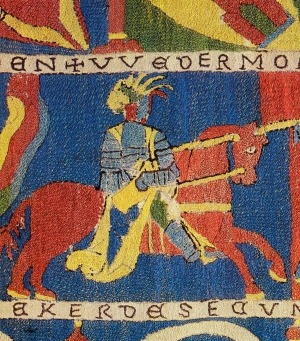Care has to be taken as the Kloster stitch is sometimes referred to as Roumanian couching, but this is worked in a slightly different manner. Kloster stitch is made from a single, straight stitch placed across the ground material. The needle and thread emerge at one end and are then used to create small slanting stitches that hold down the long thread at regular intervals.
Kloster stitch was used in medieval Germany to produce wall and church panels and hangings that were totally covered in stitching, giving the effect of a solid, usually coloured, woven wall hanging. As a result such panels/hangings are often incorrectly referred to as tapestries, but it should be stressed that they are embroideries.
Compare the Needles entry on an Osterteppich from Kloster Lüne, dated c. 1504.
In addition, Kloster stitch should not be confused with the kloster block (stitch), which is used for Hardanger embroidery and originated in Scandinavia.
Also known as: Bokhara couching; couching stitch; convent stitch
Sources:
- CLABBURN, Pamela (1976). The Needleworker’s Dictionary, London: Macmillan London Ltd, p. 68
- http://wkneedle.bayrose.org/Articles/klosterstich.html.
Digital source of illustration (retrieved 29 June 2016).
GVE

